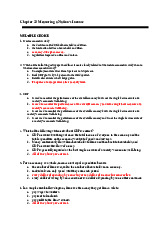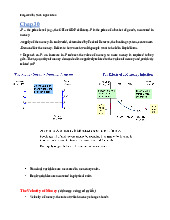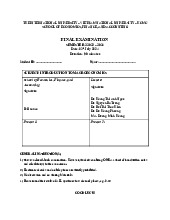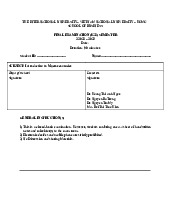




Preview text:
Chapter 32: A Macroeconomic Theory of The Open Economy Section A (MCQ) 1.
A country has $100 million of net exports and $170 million of saving. Net capital outflow is a.
$70 million and domestic investment is $170 million. b.
$70 million and domestic investment is $270 million. c.
$100 million and domestic investment is $70 million. d. None of the above is correct. 2.
In an open economy, the market for loanable funds equates national saving with a. domestic investment. b. net capital outflow. c.
the sum of national consumption and government spending. d.
the sum of domestic investment and net capital outflow. 3.
Other things the same, a higher real interest rate raise the quantity of a. domestic investment. b. net capital outflow. c. loanable funds demanded. d. loanable funds supplied. 4.
An increase in the U.S. real interest rate induces a.
Americans to buy more foreign assets, which increases U.S. net capital outflow. b.
Americans to buy more foreign assets, which reduces U.S. net capital outflow. c.
foreigners to buy more U.S. assets, which reduces U.S. net capital outflow. d.
foreigners to buy more U.S. assets, which increases U.S. net capital outflow. 5.
When a French vineyard establishes a distribution center in the U.S., U.S. net capital outflow a.
increases because the foreign company makes a portfolio investment in the U.S. b.
declines because the foreign company makes a portfolio investment in the U.S. c.
increases because the foreign company makes a direct investment in capital in the U.S. d.
declines because the foreign company makes a direct investment in capital in the U.S. 6.
Which of the following equations is always correct in an open economy? a.
I = Y - C b. I = S c.
I = S - NCO d.
I = S + NX 7.
If interest rates rose more in France than in the U.S., then other things the same a.
U.S. citizens would buy more French bonds and French citizens would buy more U.S. bonds. b.
U.S. citizens would buy more French bonds and French citizens would buy fewer U.S. bonds. c.
U.S. citizens would buy fewer French bonds and French citizens would buy more U.S. bonds. d.
U.S. citizens would buy fewer French bonds and French citizens would buy fewer U.S. bonds. 8.
How much is the saving of a country with a $50 million of domestic investment
and net capital outflow of $15 million? a. -$35 million. b. $35 million. c. -$65 million. d. $65 million. 9.
Which of the following increases when the real interest rate decreases, ceteris paribus? a. Domestic investment. b. Net capital outflow. c. Loanable funds supplied. d. Loanable funds demanded. 10.
The amount of dollars demanded in the market for foreign-currency exchange at a
given real exchange rate increase if a.
either U.S. imports decrease or U.S. exports increase. b.
either U.S. imports increase or U.S. exports decrease. c.
either U.S. imports or exports decrease. d.
either U.S. imports or exports increase.
Chapter 33 : Aggregate Demand and Aggregate Supply Section A (MCQ) 1.
An aggregate supply curve depicts the relationship between a.
the price level and the quantity of nominal GDP supplied. b.
household expenditures and household income. c.
the price level and the quantity of real GDP supplied. d.
the money wage rate and the quantity of real GDP supplied. 2. In the macroeconomic long run a.
real GDP equals potential GDP. b.
the economy is at full employment. c.
regardless of the price level, the economy is producing at potential GDP. d. All of the above are correct. 3.
The short-run aggregate supply curve is upward sloping because in the short run the a.
money wage rate changes but the price level does not. b.
price level changes but the money wage rate does not. c.
both the money wage rate and the price level change. d.
neither the money wage rate nor the price level can change. 4.
Which of the following changes does NOT shift the long-run aggregate supply curve? a. a decrease in the labor force b. a fall in the price level c.
a rise in number of college graduates in the labor force d.
a tax hike that reduces the capital stock 5.
Moving along the aggregate demand curve, a decrease in the quantity of real GDP demanded is a result of a.
an increase in the price level. b.
a decrease in the price level. c. an increase in income. d. a decrease in income. 6.
Which of the following can start an inflation? a.
An increase in aggregate demand. b.
An increase in aggregate supply. c.
A decrease in aggregate supply. d.
Both answers A and C are correct. 7.
Demand pull inflation can be started by a
a decrease in the quantity of money. b.
an increase in government expenditure. c. a decrease in net exports. d.
an increase in the price of oil. 8.
A leftward shift in the short run aggregate supply curve a.
is the result of the Fed increasing the quantity of money. b.
is the result of a rise in the price of a key resource. c.
is the result of consumer expenditures exceeding available output. d.
increases both the price level and real GDP. 9.
Suppose that the money prices of raw materials increase so that short-run
aggregate supply decreases. If the Federal Reserve does not respond, the higher
money price of raw materials will
I. repeatedly shift the aggregate demand curve rightward and raise the price level.
II. shift the aggregate demand curve rightward and the aggregate supply curve leftward, raising prices.
III. result initially in lower employment and a higher price level. a. I only b. both I and II c. both II and III d. III only 10.
The wealth effect, interest rate effect, and exchange rate effect are all explanations for a.
the slope of short-run aggregate supply. b.
the slope of long-run aggregate supply. c.
the slope of the aggregate demand curve. d.
everything that makes the aggregate demand curve shift.
Chapter 34: The Influence of Monetary and Fiscal Policy on Aggregate Demand Section A(MCQ) 1.
All of the following are part of fiscal policy EXCEPT A) setting tax rates.
B) setting government spending.
C) choosing the size of the government deficit.
D) controlling the money supply. 2.
A budget surplus ( government spending and tax ) occurs when government A)
spending exceeds tax revenues.
B) tax revenues exceeds spending.
C) tax revenues equals spending.
D) tax revenues equal Social Security expenditures. 3.
When the economy is hit by spending fluctuations, the government can try to minimize the effects by
A) changing government expenditures on goods. B) changing taxes.
C) changing government expenditures on services. D) all of the above 4.
The key goal of monetary policy is to
A) reverse the productivity growth slowdown.
B) keep the budget deficit small and/or the budget surplus large. C) lower taxes. D) maintain low inflation. 5.
Monetary policy affects real GDP by a. changing aggregate supply. b. creating budget surpluses. c. changing aggregate demand. d. creating budget deficits. 6.
Liquidity preference refers directly to Keynes' theory concerning a.
the effects of changes in money demand and supply on interest rates. b.
the effects of changes in money demand and supply on exchange rates. c.
the effects of wealth on expenditures. d.
the difference between temporary and permanent changes in income. 7.
According to the liquidity preference theory, an increase in the overall price level of 10 percent a.
increases the equilibrium interest rate, which in turn decreases the quantity
of goods and services demanded. b.
decreases the equilibrium interest rate, which in turn increases the quantity
of goods and services demanded. c.
increases the quantity of money supplied by 10 percent, leaving the interest
rate and the quantity of goods and services demanded unchanged. d.
decreases the quantity of money demanded by 10 percent, leaving the
interest rate and the quantity of goods and services demanded unchanged. 8.
If expected inflation is constant and the nominal interest rate increases by 3.5
percentage points, then the real interest rate a. increases by 3.5 percentage points. b.
increases, but by less than 3.5 percentage points. c.
decreases, but by less than 3.5 percentage points. d.
decreases by 3.5 percentage points.




